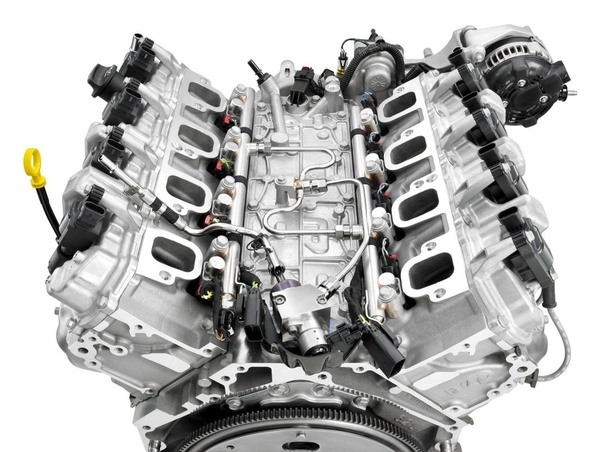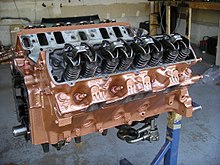
V8 engine
A V8 engine is an eight-cylinder V configuration engine with the cylinders mounted on the crankcase in two sets (or banks) of four, with all eight pistons driving a common crankshaft. Most banks are set at a right angle (90°) to each other, some at a narrower angle, with 45°, 60°, and 72° most common.
In its simplest form, the V8 is basically two parallel inline-four engines sharing a common crankshaft. However, this simple configuration, with a flat- or single-plane crankshaft, has the same secondary dynamic imbalance problems as two straight-4s, resulting in vibrations in large engine displacements.
Since the 1920s, most V8s have used the somewhat more complex crossplane crankshaft with heavy counterweights to eliminate the vibrations. This results in an engine that is smoother than a V6, while being considerably less expensive than a V12.
Most racing V8s continue to use the single plane crankshaft because it allows faster acceleration and more efficient exhaust system designs.
Application

The V8 with a crossplane crankshaft (see below) is a common configuration for large automobile engines. V8 engines are rarely less than 3.0 L (183 cu in) in displacement and in automobile use have exceeded 8.2 L (500 cu in) in production vehicles, such as the early 1970s Cadillac Eldorado. In some applications, e.g. industrial and marine V8 engines, displacement can be even larger.

In automobiles V8 engines are used in a wide variety of cars and trucks, mostly in more powerful segments and types of vehicles such as American muscle cars, sports cars, luxury cars, pickup trucks, and sport utility vehicles. Many car manufacturers offer a V8 as an option in vehicles which have a V6 or straight-6as standard engine, often casting it as a symbol of exclusivity and prestige. In some cases, V6 engines are derived from V8 designs by removing two cylinders while maintaining the same V-angle so they can be built on the same assembly lines as the V8s and installed in the same engine compartments with few modifications. Some of these employ offset crank pins driving connecting rod pairs, enabling a regular firing sequence.
The traditional 90° big-bore V8 engine, as found on many American makes, is generally both too wide and long to fit in vehicles with a transverse engine front-wheel drive layout, so its applications are limited to rear-wheel drive sports cars, muscle cars, pony cars, luxury cars and light trucks.
The shorter and occasionally narrower V6 engine is easier to fit in small engine compartments, but a few compact V8 engines are used in transverse FWD and transverse AWD engine configurations in larger cars, such as Cadillacs and Volvos. These engines often have tighter cylinder bore spacings, narrower cylinder bank angles, and other modifications to reduce their space requirements.
In motor-sports, V8s are common and have been a popular engine choice in purpose-designed engines for race-cars in many different types and classes of automotive racing, with use for example in the Formula-1 or the American NASCAR-racing league. They usually have flat-plane crankshafts, since a crossplane crankshaft results in uneven firing into the exhaust manifolds which interferes with engine tuning, and the crossplane’s heavy crankshaft counterweights can prevent the engine from accelerating rapidly. However, due to the inherent vibration that’s found in flat plane V8s, most large displacement V8s, even in motorsports, are cross-plane, including those found in NASCARand Top Fuel.
Medium-weight trucks tend to use the straight-6 configuration since it is simpler and easier to maintain, and because the straight-6 is an inherently balanced layout which can be scaled up to any size necessary. Large V8s are found in the larger truck and industrial equipment lines.
Although it was the early choice for aircraft engines, the V8 engine is seldom used in modern aircraft engine as the typically heavy crankshaft counterweights are a liability. Modern light planes commonly use the flat-8 configuration instead as it is lighter and easier to air cool. In addition it can be manufactured in modular designs sharing components with flat-4 and flat-6 engines. One of the few V8 engines used for aircraft propulsion in the World War II years was the German inverted V8 configuration, air-cooled Argus As 10 power plant.
SOURCE: Wikipedia
